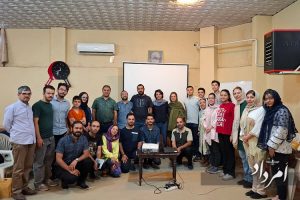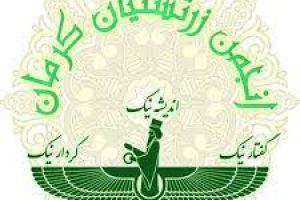Mobed Pedram Sorushpour, chief editor of Fravahar magazine, and a participant in the 34th book fair, spoke in a media interview about Iranian culture and Zoroastrian religion.
The Iranian Zoroastrian community has three publishing booths and cultural representatives at the 34th Tehran Book Fair: Fravahar, Barsam, and Hiramba Publishing Houses. From among them, Fravahar publications, being one of the oldest religious minority publications in Iran, with more than half a century history in the publication field, provided an excuse for the Redna reporter’s interview with the editor of this publication, Mobed Pedram Soroushpour. The Zoroastrian magazine, Fravahar, has 50 years of active experience.
Mobed Pedram Soroushpour is one of the Iranian Zoroastrian community’s well-known figures and cultural activists who has published several works in Iranian history and culture. Soroushpour has been working as the secretary of the Mobedan Association of Tehran for a long time and the editor of the bimonthly cultural, religious, and social magazine “Fravahar.” Referring to one of the concerns of the Zoroastrian community in Iran, Mobed Pedram Sorushpour had an interview with Adyan news reporter about Iranian culture and the Zoroastrian religion:
“Fravahar is one of the oldest Iranian written magazines that has been continuously published in the past years, and now it is the 54th year of publication of this Zoroastrian magazine, which has been printed in 500 volumes. “Fravahar deals, in two sections, with ancient Iranian culture and Zoroastrian religious culture.”
Iran: the land of religions and one of the oldest monotheistic nations in the world. In response to the reporter’s question: “As one of the religious minorities in Iran, to what extent does the Zoroastrian community have freedom in practicing their religious beliefs and culture; The member of the Mobed Association said: This freedom exists entirely. and this is natural because Iran is the land of religions, and we are one of the oldest monotheistic nations in the world. In history, great people like Achaemenid Cyrus are known worldwide as a symbol of religious tolerance.”
He continued: “For this reason Iranian culture has been one of tolerance and has been open to all ideas and other religions, and other religions and accepted them.” The existence and presence of the largest Jewish synagogues, Christian churches, and other religious and holy places of different religions indicate Iranians’ peaceful view towards “other” cultures and religions.”
Mehergan and other Zoroastrian festivals are part of Iranians’ identity, history, and culture
Referring to one of the concerns of Iran’s Zoroastrians, the editor of “Fravahar” magazine told Adyan News reporter: “Unfortunately, sometimes we put culture as opposed to religion.” While parts of ancient Iranian culture, such as the Mehergan, Sadeh, Esfandgan, etc., are part of the history and identity, and culture of the Iranian nation and they do not belong to any particular religion because even before Zoroastrianism, we celebrated the Mehergan and it is related to identity and the cultural history of Iran.
Separating Zoroastrian religion from Iranian culture should not happen.
He continued: “In addition, neglecting and forgetting a part of cultural trends and not paying attention to them on the pretext of putting culture as opposing to religious issues will have grave consequences. Because many times they do not allow Zoroastrians and Iranians to celebrate these festivals and national cultures together. The separation between “Zoroastrian” and “Iranian culture” should not happen. I hope this issue will create concern for numerous institutions because culture and cultural symbols are considered as mother of all social needs in society.”
Pedram Sorooshpour stated the purpose of Fravahar publications and activities in this field is to give importance to the issue of religious dialogues and beliefs that most of the things we learn come from religious dialogues. All our efforts are for providing first-hand scientific and academic sources regarding Iran’s ancient and national culture and history to those interested. Co-existence between Zoroastrian citizens and the Jewish, Christian and Muslims will happen when there is respect for culture and religious identity.
In the end, the reporter asked the member of Tehran Mobed Association: “What is the power and importance of addressing Zoroastrian celebrations and Iranian culture and history?” And he said in response: The peaceful life of Zoroastrian, Christian, and Jewish citizens takes place alongside each other with mutual respect between people and care for their culture and identity. For instance when Mehregan is celebrated as a ring of love and friendship between people with different beliefs and tendencies.
The name of Achaemenid Cyrus appears in the Torah, the Quran, and the holy books of Christians.
In the end, he pointed out: We should know that seven thousand years of civilization and five thousand years of Iranian culture have been established and flowed in this land in search of solidarity, peace, kindness, unity, and friendship between people with different beliefs. Achaemenid Cyrus, nicknamed Dhu al-Qarnayn by Allameh Tabataba’i, is found in the Torah of the Jewish Bible and the writings of Christians. For this reason, unfortunately, sometimes, instead of respecting cultural, historical, and religious characters, we confront it.










